Balsamic Roasted Root Vegetables: A Stunning & Simple Sheet Pan Side Dish
Discover the ultimate vegetable side dish that combines stunning presentation with incredible ease of preparation. This sheet pan recipe for Balsamic Roasted Root Vegetables is not only naturally vegan, gluten-free, and incredibly healthy, but it’s also bursting with flavor. Perfect for any occasion, from a festive Thanksgiving feast to a simple weeknight meal, this recipe will transform your perception of humble root vegetables into a culinary masterpiece.

Are you searching for a versatile and impressive side dish that effortlessly ticks all the boxes? One that is equally delicious, visually appealing, packed with nutrients, and incredibly simple to prepare? Look no further. Our Balsamic Roasted Root Vegetables recipe delivers all this and more. With just one sheet pan, a few minutes of active prep, and the magic of the oven, you’ll create a side dish that’s not only beautiful to behold but also unbelievably tasty. It’s the perfect addition to your Thanksgiving spread, an elegant holiday dinner, or a wholesome everyday meal.
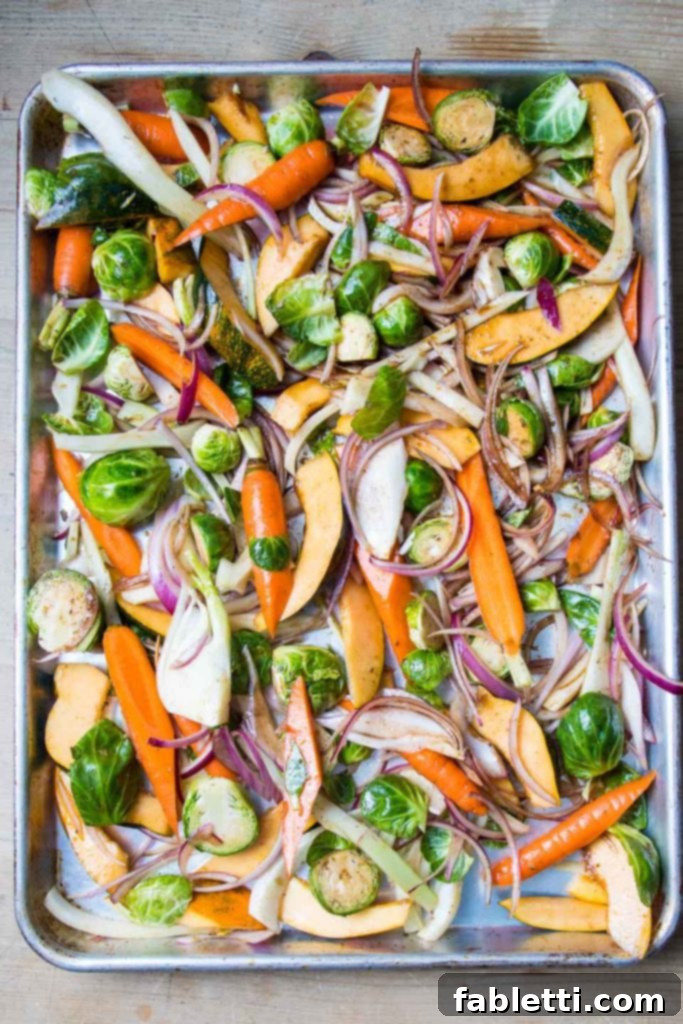
Why Roasting is the Best Way to Enjoy Root Vegetables
I genuinely adore easy recipes for roasted vegetables. Roasting at a high temperature is a culinary secret weapon that coaxes out the natural sweetness locked within vegetables, transforming their flavor profile into something truly extraordinary. The intense heat promotes caramelization, creating slightly crisp edges and tender, succulent interiors. This process, known as the Maillard reaction, deepens the flavors and adds an irresistible complexity that simple steaming or boiling simply cannot achieve. Plus, it’s a remarkably hands-off cooking method, allowing you to focus on other aspects of your meal while the oven does most of the work.
This recipe offers incredible flexibility, allowing you to select any variety of seasonal root vegetables you prefer. For this particular dish, I’ve chosen a vibrant mix of acorn squash, fennel, Brussels sprouts, carrots, and purple onions. I love how their diverse colors create a visually stunning plate, and the artful presentation is enhanced when the vegetables are cut into larger, rustic chunks. However, feel free to experiment with parsnips, sweet potatoes, beets, or even regular potatoes – the balsamic glaze works wonderfully with almost any hearty vegetable.

Are Balsamic Roasted Root Vegetables Healthy? Absolutely!
This recipe for Balsamic Roasted Root Vegetables is truly a delightful deception. When you look at the stunning plate, overflowing with colorful, caramelized vegetables, you might wonder if something so beautiful could actually be incredibly good for you. The answer is a resounding yes! Each vegetable brings a unique array of vitamins, minerals, and antioxidants to the table, making this dish a powerhouse of nutrition.
- Acorn Squash: A fantastic source of dietary fiber, which aids digestion and promotes satiety. It’s also rich in Vitamin C, boosting your immune system, along with potassium for heart health and magnesium for muscle and nerve function.
- Carrots: Renowned for their high beta-carotene content, which converts to Vitamin A in the body, essential for vision and skin health. They also provide ample fiber, Vitamin K (important for blood clotting), and powerful antioxidants that help fight free radical damage.
- Fennel: A unique vegetable loaded with fiber, potassium, folate (crucial for cell growth), vitamin C, and an impressive profile of phytonutrients with anti-inflammatory properties. Its distinct anise flavor mellows beautifully when roasted.
- Brussels Sprouts: These mini cabbages are fiber-rich powerhouses, packed with vitamins (especially Vitamin K and C), minerals, and potent anti-oxidants that support overall health and detoxification.
- Purple Onions: More than just a flavor enhancer, purple onions are full of beneficial compounds, including anthocyanins (which give them their color) and quercetin, known for their ability to fight inflammation, decrease triglycerides, and help reduce cholesterol levels.
Here’s a wonderful opportunity to nourish your body with ease and elegance. This dish proves that sometimes, beauty isn’t just skin deep—it comes with incredible substance and brain-boosting nutrients!
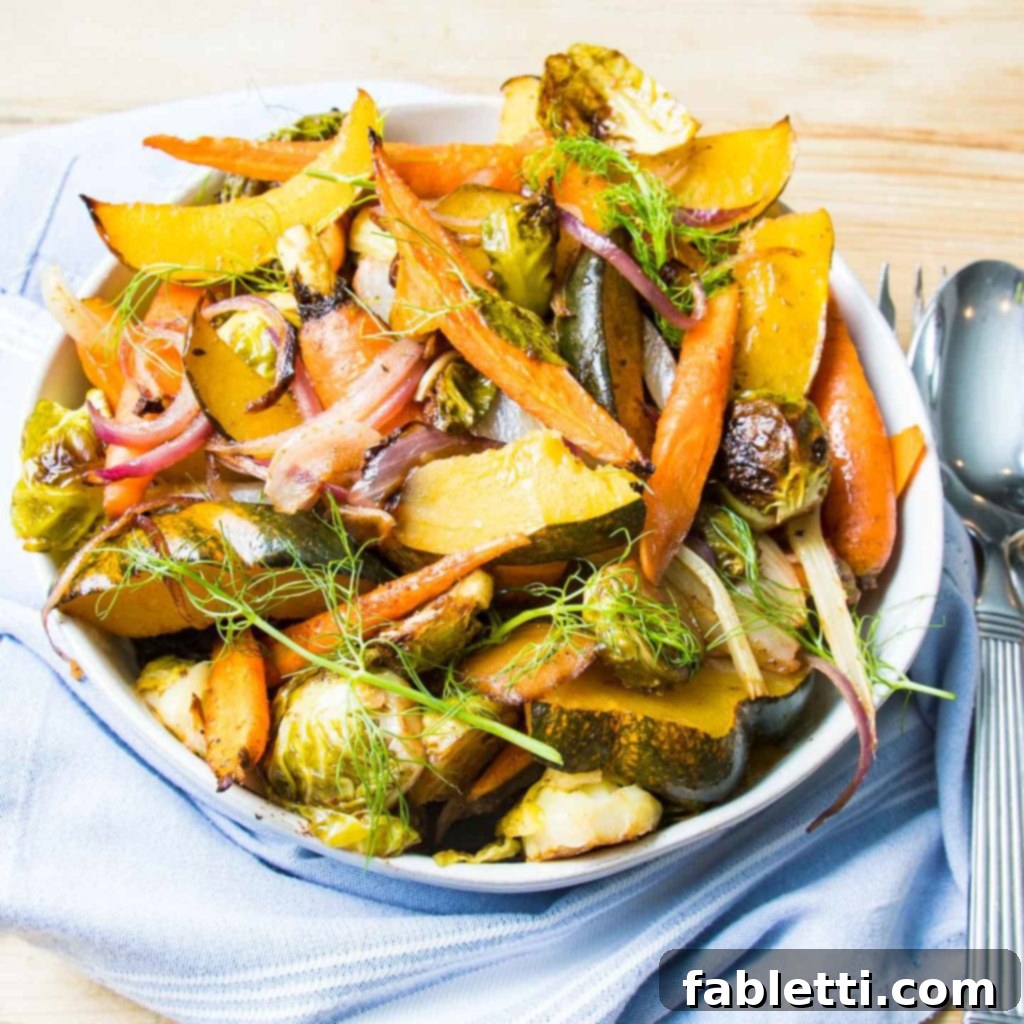
How to Cut Acorn Squash with Ease
I confess, whole squash used to intimidate me. The hard exterior seemed daunting, making me shy away from recipes. When I finally decided to embrace acorn squash, I initially opted for an easy mashed version, which was delicious and conveniently didn’t require slicing. However, a culinary revelation occurred when I tasted roasted acorn squash with its skin still on. You can eat the skin? That was a game-changer! Armed with a sharp knife, I haven’t looked back since. Properly cutting acorn squash is simpler than you might think and eliminates the need for peeling, saving you time and effort while retaining extra nutrients.
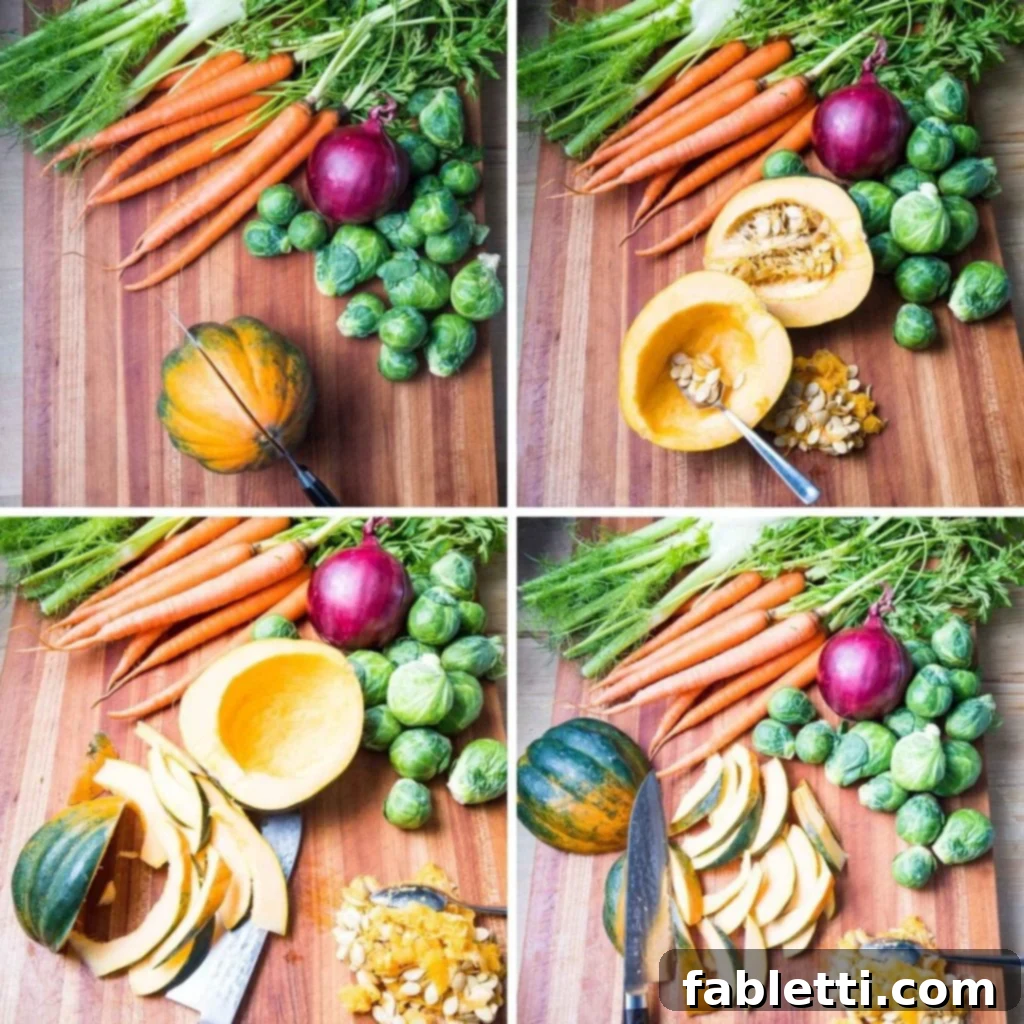
- Begin by thinly slicing off the top, including the stem if it’s still attached, to create a flat, stable surface. This is crucial for safety, allowing you to securely place the squash on a cutting board without it rolling or wobbling.
- Using a sturdy, sharp chef’s knife, carefully cut through the squash lengthwise, halving it from end to end. Apply steady pressure and rock the knife gently if needed.
- Once halved, use a spoon to scoop out the seeds and any stringy pulp from the center of each half. A grapefruit spoon, with its serrated edge, works exceptionally well for this task. Don’t discard the seeds; they can be dried and roasted just like pumpkin seeds for a crunchy snack!
- Lay the flat (cut) side of each squash half down on your cutting board. Then, slice it into wedges of your desired thickness. For roasting, thicker wedges (about 1/2 to 3/4 inch) work best as they hold their shape and caramelize beautifully.
Mastering the Art of Trimming and Slicing Fennel
Fennel, with its bulbous base and delicate fronds, often appears intimidating to those unfamiliar with it. However, learning how to trim and slice this aromatic vegetable is remarkably straightforward and opens up a world of culinary possibilities. Its mild anise flavor transforms into a tender, sweet delight when roasted, making it a perfect complement to the other root vegetables in this dish.
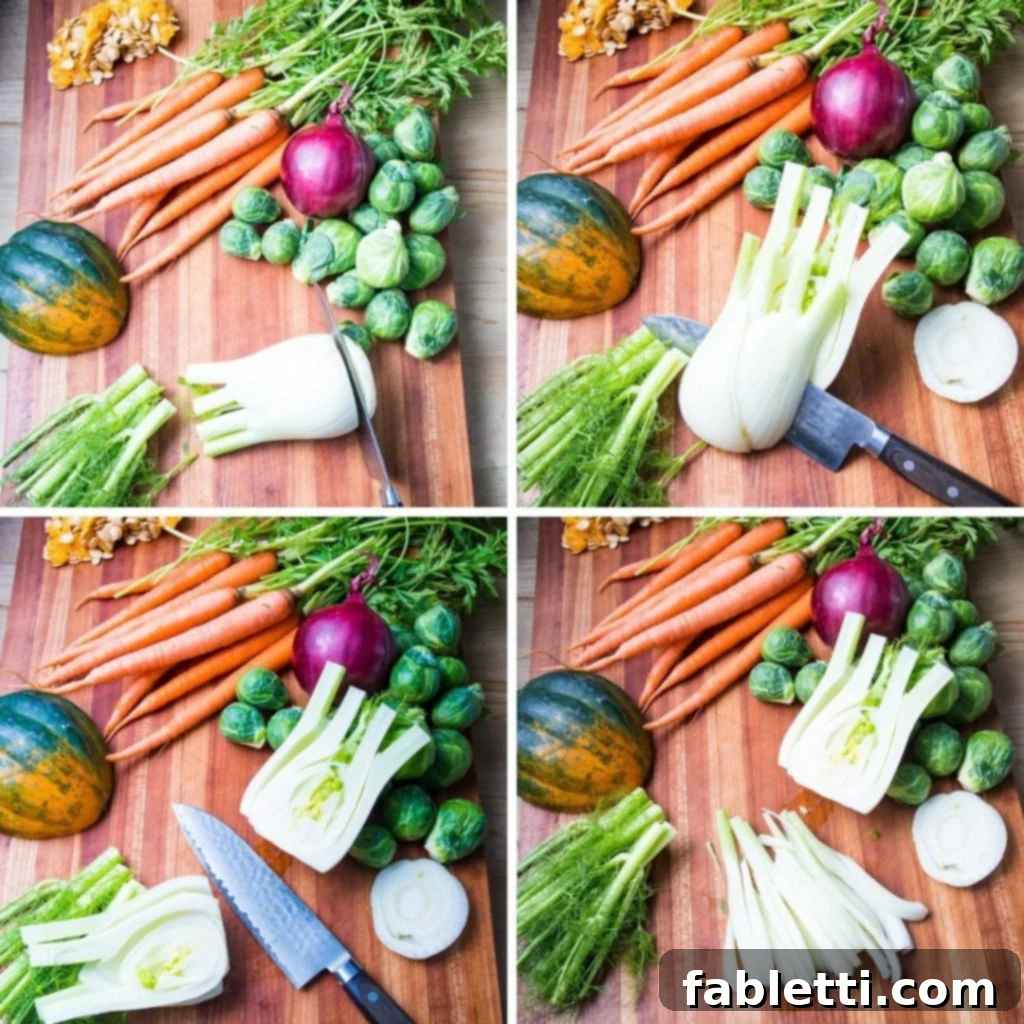
- Start by cutting off the feathery fronds from the top of the fennel bulb. These delicate leaves are edible and have a lovely, subtle anise flavor. I highly recommend saving them to use as a fresh, aromatic garnish once your roasted vegetables emerge from the oven.
- Next, trim off the woody bottom core of the bulb. You want to remove just enough so that the base is flat and stable.
- Stand the fennel bulb upright on its newly flattened surface on your cutting board. Using a sharp knife, cut through the top to halve the bulb lengthwise.
- Place each cut side down on the cutting board and slice the fennel into pieces of your desired thickness. For roasting, aim for slices that are about 1/4 to 1/2 inch thick, ensuring they cook evenly and become beautifully tender.

Thanksgiving and other holiday gatherings often come with a roster of traditional dishes that are simply non-negotiable. It can be challenging to introduce new and different items when everyone has cherished expectations. In many households, vegetables and healthy food, while appreciated, might not always be at the top of the most-anticipated list. Years ago, I discovered that preparing a vibrant vegetable medley is the perfect solution. This approach allows me to effortlessly incorporate abundant nutrition, diverse flavors, and beautiful colors with minimal fuss. It’s also a fantastic option for hosts and guests alike who might be experiencing “decision fatigue” from an already elaborate menu. This roasted root vegetable medley offers a fresh, wholesome, and delicious contrast to richer holiday fare, ensuring there’s something satisfying for every palate.
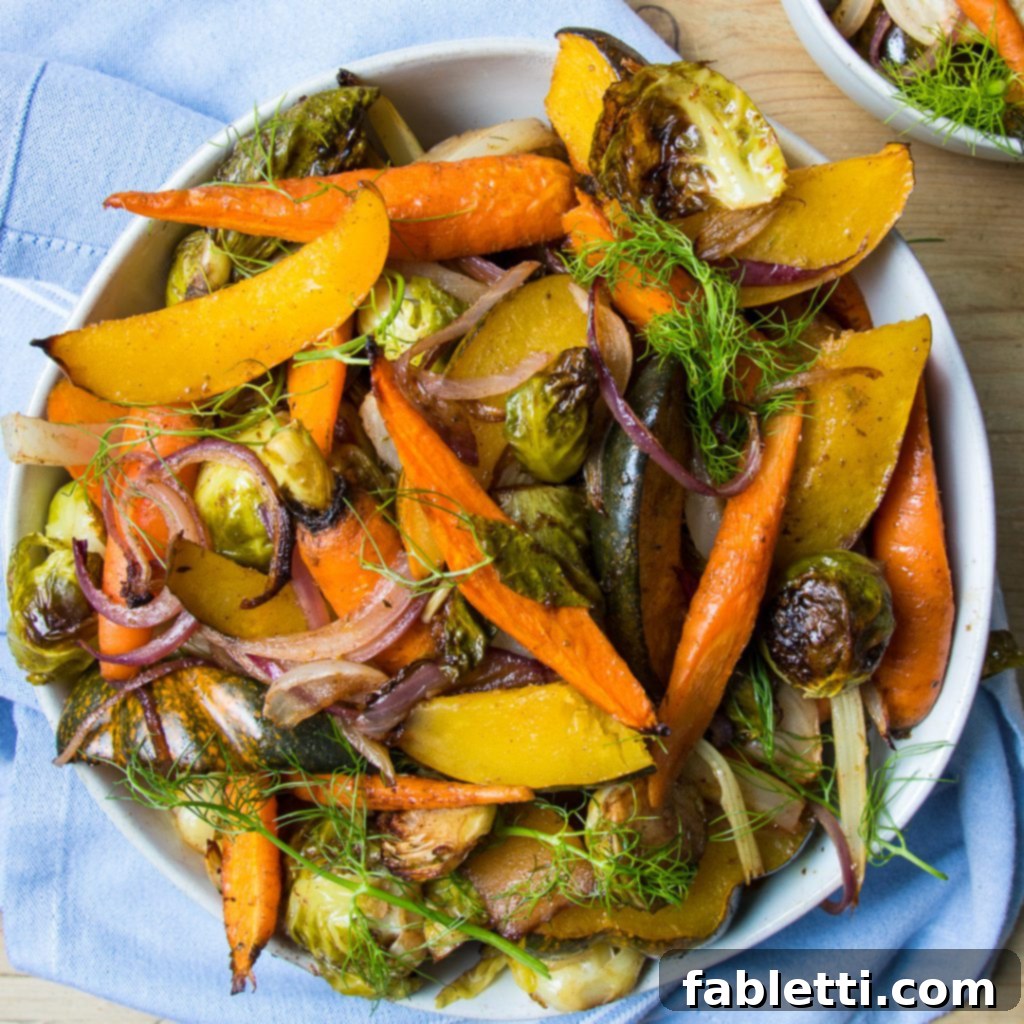
Did you know that commenting and rating recipes is one of the best ways to support your favorite food bloggers? If you made this delicious recipe, please consider leaving a five-star rating below and a comment sharing your experience. We also love seeing your creations! Please share your photos on Instagram by tagging me @dkhealthcoach and using the hashtag #debraklein. Your support means the world!
📖 Recipe: Balsamic Roasted Root Vegetables
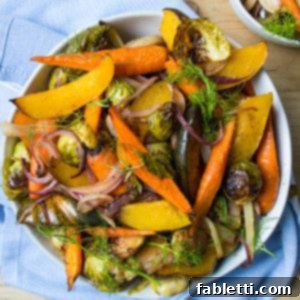
Balsamic Roasted Root Vegetables
Debra Klein
Rate this Recipe
Pin Recipe
10 mins
30 mins
40 mins
Side Dish
Healthy
10 servings
129 kcal
Equipment
- Stainless Steel Baking Sheets
- Balloon whisk
- Global 8″ Chef’s Knife
- Extra Large Bamboo Cutting Board
- Stainless steel mixing bowls
- Garlic press
Ingredients
Vegetables
- 1 acorn squash
- 1 large bulb fennel
- 1 large purple onion
- 1 lb. carrots
- 1 lb. Brussels sprouts
- Coarse Sea Salt + Pepper to taste
Marinade
- ¼ cup olive oil
- 2 Tablespoons balsamic vinegar
- 1 Tablespoon maple syrup
- 3 cloves garlic pressed
- 1 teaspoon cinnamon
- 1 teaspoon cumin
- ½ teaspoon oregano
Instructions
- Preheat your oven to 425°F (220°C). Arrange an oven rack in the middle position to ensure even cooking and optimal caramelization.
- Prepare your vegetables and place them into a very large mixing bowl. The key to successful roasting is uniform size for even cooking, so chop your vegetables accordingly.
ACORN SQUASH: Halve the squash, scoop out the seeds with a spoon. Place the cut side down on your cutting board and slice it into long, thin wedges (about ½ to ¾ inch thick). There’s no need to peel the skin!
FENNEL: Trim off the feathery fronds from the top (reserve these for garnish if desired) and a thin slice off the woody bottom core. Cut the bulb in half lengthwise, then slice each half into thin pieces (about ¼ to ½ inch thick).
PURPLE ONION: Halve the onion, then slice it thinly into crescent shapes. Separate the layers to ensure they roast evenly.
CARROTS: Peel the carrots if desired, then cut them into long spears or diagonal slices, aiming for a similar thickness to the squash.
BRUSSELS SPROUTS: Trim the very bottoms of the sprouts. Halve any larger sprouts to ensure they cook at the same rate as the smaller ones, and achieve that perfect crispy exterior.
- Prepare the Marinade: In a small bowl, whisk together the olive oil, balsamic vinegar, maple syrup, pressed garlic, cinnamon, cumin, and oregano until well combined. Pour this aromatic marinade over the prepared vegetables in the large bowl. Toss vigorously to ensure all the vegetables are evenly coated with the rich, flavorful glaze.
- Roast: Transfer the marinated vegetables to one or two large rimmed baking sheets, ensuring they are spread out in a single layer without overcrowding. Overcrowding can lead to steaming instead of roasting, preventing proper caramelization. If necessary, use two baking trays. Sprinkle generously with coarse sea salt and freshly ground black pepper to enhance their natural flavors.
- Bake for 30 minutes, or until the squash and carrots are fork-tender and the Brussels sprouts have crispy edges and a deep golden color. The exact roasting time may vary slightly depending on your oven and the size of your vegetable chunks. For extra crispiness, you can flip the vegetables halfway through baking.
Notes
REHEATING LEFTOVERS: Leftover roasted vegetables can be reheated beautifully. Simply spread them on a baking sheet and warm them in a 400°F (200°C) oven for about 10-15 minutes, or until thoroughly heated through and slightly re-crisped. Avoid reheating in the microwave, as it can make them soggy.
Nutrition
Calories: 129kcal
Carbohydrates: 15g
Protein: 2g
Fat: 8g
Saturated Fat: 1g
Polyunsaturated Fat: 6g
Sodium: 44mg
Fiber: 4g
Sugar: 5g
Note
The nutrition calculations provided were estimated using online tools. To obtain the most accurate representation of the nutritional information for any given recipe, it is recommended that you calculate it with the actual ingredients and brands you use. You are ultimately responsible for ensuring that any nutritional information is accurate, complete, and useful for your dietary needs.
Did you make this recipe?
Please leave a review below, then snap a picture and tag me @dkhealthcoach or use hashtag #dkhealtcoach on Instagram so I can see it!!
